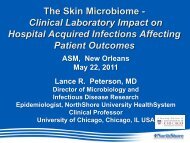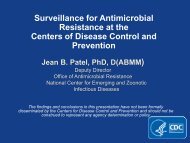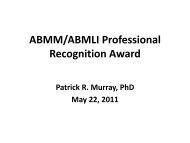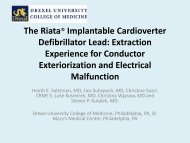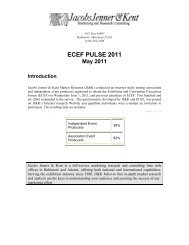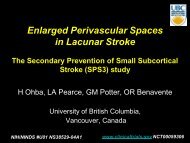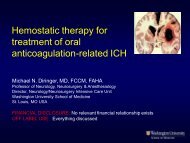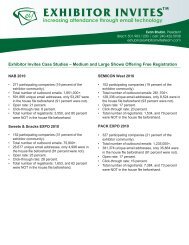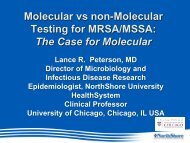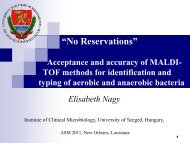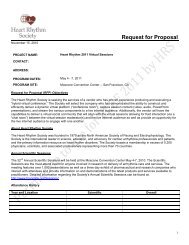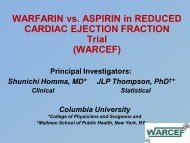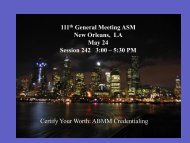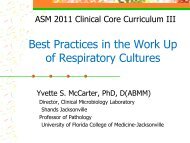Reversible Cerebral Vasoconstriction Syndromes (RCVS)
Reversible Cerebral Vasoconstriction Syndromes (RCVS)
Reversible Cerebral Vasoconstriction Syndromes (RCVS)
You also want an ePaper? Increase the reach of your titles
YUMPU automatically turns print PDFs into web optimized ePapers that Google loves.
<strong>Reversible</strong> <strong>Cerebral</strong> <strong>Vasoconstriction</strong><br />
<strong>Syndromes</strong> (<strong>RCVS</strong>)<br />
Aneesh B. Singhal, M.D.<br />
Associate Professor of Neurology<br />
Harvard Medical School<br />
Stroke Service, Mass. General Hospital
<strong>Cerebral</strong> Arteriopathies<br />
• Cause stroke and vascular headache<br />
• Overall, the most common cause of stroke<br />
– 20% to 50% in older adults (LAA and SVD)<br />
– 30% to 40% in young adults<br />
– > 50% in children<br />
[1] Baltimore-Washington Cooperative Young Stroke Study.<br />
[2] Helsinki Young Stroke Registry.<br />
[3] International Pediatric Stroke Study.<br />
[4] Wong LK. Global burden of intracranial atherosclerosis. Int J Stroke. 2006
Patients (mostly women): rTCH ± stroke/seizure<br />
A<br />
D<br />
B C<br />
E<br />
? PACNS CSF, vasculitis labs, brain biopsy negative<br />
Some treated with empiric steroids / cyclophosphamide<br />
F
Nomenclature: 1960s – 2000s<br />
• Call or Call-Fleming syndrome<br />
• Postpartum angiopathy<br />
• Eclampsia associated vasoconstriction<br />
• Migraine ‘angiitis’<br />
• Thunderclap HA with reversible ‘vasospasm’<br />
• Drug induced ‘angiitis’<br />
• CNS ‘pseudovasculitis’<br />
• Benign angiopathy of the CNS (BACNS)<br />
‘<strong>RCVS</strong>’ includes all of the above
Key Elements for Diagnosis<br />
1. Severe, acute, recurrent ‘thunderclap’<br />
headache with or without additional neurologic<br />
signs or symptoms<br />
2. DSA / CTA/ MRA : multifocal vasoconstriction<br />
3. No evidence for aneurysmal SAH<br />
4. Normal CSF (protein
MGH and Cleveland Clinic Data
Characteristic<br />
Clinical Features<br />
CCF<br />
(n=55)<br />
MGH<br />
(n=84)<br />
Mean age (yrs) 43 +/- 11 42+/-12 0.65<br />
Female 80% 82% 0.75<br />
Caucasian 76% 82% 0.52<br />
Associated Trigger<br />
(?)<br />
Postpartum 4% 12% 0.12<br />
Idiopathic 45% 29% 0.042*<br />
Drugs 36% 61% 0.005*<br />
Migraine 24% 50% 0.002*<br />
P
Characteristic<br />
Clinical Features<br />
CCF<br />
(n=55)<br />
MGH<br />
(n=84)<br />
Any HA at onset 95% 95% 0.99<br />
Thunderclap 84% 86% 0.99<br />
Recurrent TCH 74% 87% 0.06<br />
Focal deficits 38% 46% 0.34<br />
Onset seizures 16% 18% 0.82<br />
Presented
Laboratory and Imaging Features<br />
Characteristic<br />
CCF<br />
(n=55)<br />
MGH<br />
(n=84)<br />
CSF performed 80% 77% 0.71<br />
CSF protein
Characteristic<br />
Brain Imaging<br />
CCF<br />
(n=55)<br />
MGH<br />
(n=84)<br />
First CT or MRI normal 57% 55% 0.83<br />
Any CT / MRI abnormal 79% 73% ns<br />
Lesion Patterns<br />
Cortical surface SAH 23% 42% 0.022*<br />
Ischemic stroke 38% 40% 0.75<br />
Lobar hemorrhage 23% 18% 0.49<br />
P
Characteristic<br />
Follow-up Imaging<br />
CCF<br />
(n=55)<br />
MGH<br />
(n=84)<br />
F/up CTA, MRA, DSA 60% 70% 0.21<br />
F/up TCD only 35% 30% 0.55<br />
Full Reversibility 76% 73% 0.69<br />
Partial Reversibility 21% 26% 0.61<br />
No Reversibility 2.4% 1.5% 0.99<br />
Median F/up (days) 66<br />
(27,152)<br />
56<br />
(30,94)<br />
P<br />
0.35
<strong>Cerebral</strong> Angiography<br />
‘beading’<br />
‘sausage-on-a-string’<br />
<strong>RCVS</strong>: Brain Imaging<br />
Diffusion-MRI<br />
symmetric infarcts<br />
watershed regions<br />
FLAIR-MRI<br />
vasogenic edema<br />
(posterior leukoencephalopathy<br />
)
<strong>RCVS</strong>: Brain Imaging
RCV, RPLS, ICH, ICA-dissection
Brain Hemorrhage in <strong>RCVS</strong><br />
Hemorrhages are common, more so in women, and<br />
frequently assoc. with vasoconstrictive drugs<br />
Types<br />
1. Small non-aneurysmal cortical surface SAH<br />
2. Parenchymal ICH – lobar (single or multiple)<br />
3. Subdural hemorrhage<br />
CT and FLAIR<br />
Cortical SAH<br />
GRE-MRI<br />
Cortical SAH<br />
CT<br />
Lobar ICH<br />
GRE-MRI<br />
Cerebellar ICH
Pathophysiology<br />
TCH<br />
<strong>RCVS</strong><br />
PRES<br />
overlapping clinical, imaging features…<br />
?shared pathophysiology<br />
endothelium, perivascular nerves, serotonin, epinephrine
• Migraine<br />
Differential Diagnosis<br />
• Thunderclap headache (TCH)<br />
– aneurysmal SAH, intracerebral hemorrhage,<br />
CVST, pituitary apoplexy, viral encephalitis,<br />
vertebral or carotid dissection, PCA embolus<br />
• Similar angiographic abnormalities<br />
– Primary angiitis of the CNS (PACNS)<br />
– Moyamoya disease<br />
– FMD<br />
– Intracranial atherosclerosis
Distinguishing <strong>RCVS</strong> from PACNS<br />
Feature <strong>RCVS</strong> PACNS<br />
Headache Recurrent TCH Insidious, chronic<br />
Infarct pattern ‘Watershed’ Small, scattered<br />
Lobar H’rrge Common Rare<br />
Cortical SAH Common Rare<br />
<strong>Reversible</strong> edema Common -<br />
Angiogram Sausage on a<br />
string (smooth)<br />
Irregular, notched,<br />
ectasia
Diagnostic Approach<br />
1. Clinical Recognition (rTCH)<br />
2. Brain Imaging (lesion patterns)<br />
3. Angiography (‘sausage-string’)<br />
<strong>RCVS</strong>: an “instantly recognizable” condition
<strong>RCVS</strong> Treatment Options<br />
1. Simple observation !!<br />
2. IV fluids, pain management, laxatives<br />
3. Avoid precipitants e.g. vasoconstrictive drugs<br />
4. Avoid blood pressure modulation<br />
5. Ca ++ channel blockers (nimodipine, verapamil, Mg)<br />
6. Short course of steroids (best avoided!!)<br />
7. Fulminant cases: balloon angioplasty, IA nicardipine
Characteristic<br />
Treatment and Outcomes<br />
CCF<br />
(n=55)<br />
MGH<br />
(n=84)<br />
Ca Channel Blockers 87% 46%
Regression: predictors of poor outcome<br />
Factor All Patients<br />
P Value<br />
MGH Cohort<br />
P Value<br />
Age 0.61 0.95<br />
Female 0.87 0.74<br />
CaCB 0.27 0.98<br />
Steroids 0.09 < 0.001<br />
MGH of 23 patients who received steroids, 11<br />
(48%) had new symptoms and new infarcts<br />
within 2-6 days after steroid initiation
CTA before IA treatment (PPD 20)<br />
Singhal et al., New Eng J Med 2009
CTA after IA treatment<br />
Singhal et al., New Eng J Med 2009
Final MRI 6 Days After Admission<br />
Singhal et al., New Eng J Med 2009
Autopsy: no evidence for inflammation<br />
Distal left MCA
<strong>RCVS</strong><br />
• Group of conditions characterized by reversible<br />
segmental constriction-dilatation of cerebral arteries<br />
• ~90% have recurrent ‘thunderclap’ headaches<br />
• Brain MRI can be normal or show ischemic stroke,<br />
ICH, cSAH, or reversible brain edema (PRES)<br />
• Usually a self-limited condition with benign outcome<br />
• Angiographic reversal occurs within days to weeks<br />
• Pathophysiology: ?abnormal cerebral vascular tone<br />
Singhal et al., Arch Neurol 2011; Calabrese et al., Ann Int Med 2007;<br />
Ducros et al., Brain 2007; Chen et al., Ann Neurol 2008, 2010
Next Steps<br />
International Collaboration<br />
Validate provisional diagnostic criteria<br />
Define relationships with PRES and TCH<br />
Clarify whether drugs can precipitate <strong>RCVS</strong><br />
Pathophysiology – biomarkers, autoregulation<br />
Investigate treatments e.g. nimodipine<br />
What’s first, headache or vasoconstriction?<br />
Why ‘segmental’? Why prolonged?
Stroke attributed to<br />
‘vasospasm’ for centuries<br />
1950s: Pathological entities<br />
- Carotid athero<br />
- Atrial fibrillation<br />
- Lacunar<br />
‘Vasospasm’ not implicated<br />
- except SAH<br />
- except rare migraine<br />
1971, 1975: Salpetrierre Conf.<br />
1988: Call-Fleming Syndrome<br />
C. Miller Fisher, MD
M. Akif Topcuoglu, MD (circa 2002)
Hemorrhages in 1 st week, Infarcts in 2 nd week
Additional Slides<br />
- Pathophysiology<br />
(BHI, endothelium/p-v nerves, drugs)<br />
- Migraine vs. <strong>RCVS</strong><br />
- <strong>RCVS</strong> vs. PACS
Pathophysiology
Pathophysiology of <strong>RCVS</strong><br />
- ‘migrainous vasospasm’<br />
- ‘mechanical’: catheter-induced vasospasm<br />
- ‘angiographic dye’ - bradykinin<br />
- sympathomimetic (ergot, amphetamine, cocaine)<br />
- endothelin-1, nitric oxide, substance P, CGRP<br />
- female reproductive hormones<br />
- serotonin<br />
- calcium
A B<br />
C<br />
(A) Headframe used for bedside TCD examination.<br />
Breath Holding Index<br />
%(V apnea-V baseline)<br />
V baseline x t apnea<br />
Normal = 1.2 ± 0.6<br />
(B) Representative CT-angiogram showing multifocal segmental stenosis<br />
(“beading”) of the bilateral middle cerebral arteries, basilar, posterior<br />
cerebral, and superior cerebellar arteries.<br />
(C) TCD spectrum showing elevated mean flow velocity in the left MCA.
TCD response to Apnea (breath-hold)<br />
Percentage Change of CBFV (%)<br />
20<br />
15<br />
10<br />
5<br />
0<br />
-5<br />
-10<br />
-15<br />
-20<br />
Control Migraine <strong>RCVS</strong><br />
BH start Min BH end
Perivascular nerves<br />
smooth muscle cells<br />
endothelial cells
Perivascular Nerves<br />
• Perivascular nerves release various<br />
neurotransmitters and peptides, including 5-HT (Reinhard<br />
et al., Science, 1979, 206: 85)<br />
• Perivascular nerves contain catecholamines, but<br />
vasoconstriction from norepinephrine is poor across<br />
species, including humans (Bevan et al., Stroke, 1998, 29: 212.)<br />
• Interestingly, perivascular sympathetic nerves take<br />
up serotonin both in vitro and during the early phase<br />
of subarachnoid hemorrhage (Szabo et al., Stroke, 1992, 23: 54.)
Endothelium<br />
• Modulates vascular caliber by producing and<br />
releasing EDRFs such as NO, PGI2, EDHF<br />
• Cerebrovascular endothelial dysfunction might<br />
be related to vasoconstriction in <strong>RCVS</strong>-PRES?<br />
• Increased plasma levels of soluble antiangiogenic<br />
factors (sFlt1, endoglin) documented<br />
in pre-eclampsia and may underlie the<br />
endothelium dysfunction.<br />
(Levin et al. NEJM 2004, 2006; Singhal et al, NEJM 2009)
Hypothesis<br />
• Raphe nuclei in the brainstem, projections to<br />
peri-vascular nerves<br />
– trigeminovascular system and serotonergic pathways<br />
• Increased serotonin, NE levels in nerve endings<br />
• Might explain the headache, hyper-reflexia,<br />
segmental vasoconstriction, depression in <strong>RCVS</strong><br />
• Distal capillary bed - serotonergic effects may<br />
explain edema, overlap with PRES<br />
• In addition, endothelial dysfunction might be<br />
related to vasoconstriction in <strong>RCVS</strong>-PRES?<br />
– soluble anti-angiogenic factors (sFlt1, endoglin)<br />
• (Levin et al. NEJM 2004, 2006; Singhal et al, NEJM 2009)
Spectrum - disorders of cerebrovascular tone?<br />
Headache, vasoconstriction-vasodilatation<br />
Stroke<br />
Ischemic<br />
ICH<br />
cSAH<br />
Dissection<br />
TCH<br />
Other 1° Headaches<br />
Hypertensive enceph.<br />
Eclampsia<br />
Porphyria<br />
Head trauma<br />
Post-CEA<br />
Sympathomimetic drugs<br />
Serotonergic drugs<br />
- etc -<br />
Edema<br />
(PRES)
Inter-relationship between <strong>RCVS</strong> & PRES<br />
4 postpartum patients with RCV & PRES<br />
A<br />
B<br />
C D D<br />
Singhal AB, Arch Neurol 2004;61:411-6<br />
b<br />
A<br />
B<br />
C
<strong>RCVS</strong> and Drugs/Meds<br />
Ergot derivatives (bromocryptine, ergotamine, lisuride)<br />
Nasal decongestants (ephedrine, phenylpropanolamine)<br />
Diet pills (metabolife, ephedra supplements, ma huang)<br />
Cocaine, amphetamines, LSD, marijuana<br />
Cyclosporin A<br />
Erythropoetin, RBC transfusion, Hypercalcemia<br />
Licorice<br />
Intravenous immune globulin<br />
Sumatriptan<br />
SSRIs, in combination with other vasoactive drugs<br />
Hormonal – OCPs
<strong>RCVS</strong> and serotonergic drugs<br />
Drugs and ICH: epidemiological studies controversial<br />
•Hemorrhagic Stroke Project: PPA in diet pills, ephedra<br />
• Korean Study: PPA in cold remedies<br />
• Mexican study: sympathomimetics<br />
Association of drugs with <strong>RCVS</strong> remains anecdotal
Serotonin – central role in <strong>RCVS</strong>?<br />
Sumatriptan: 5-HT 1B,D receptors<br />
Cocaine, amphetamines: sympathomimetic + serotonergic actions<br />
Diet pills: stroke, “carcinoid” heart & lung lesions (NEJM 1997)<br />
Subarachnoid hemorrhage: ? neuronal serotonin uptake/release<br />
Migraine related stroke: ?serotonergic mechanisms<br />
Head injury: ? release of serotonin from brain, platelets<br />
Porphyria: liver tryptophan pyrrolase is haem-dependant; haem<br />
deficiency in porphyria elevates 5-HT levels (Nature 1983)<br />
Serotonin Syndrome: assoc. with migrainous stroke (Headache 1997)
Serotonin – further evidence<br />
• SSRIs associated with digit ischemia<br />
• serotonin implicated in Raynaud’s phenomenon<br />
• sumatriptan and Prinzmetal’s angina, MI<br />
• sumatriptan and mesenteric ischemia<br />
• Diet pills: sympathomimetic + serotonergic<br />
effects, reversible cardiac valvular lesions and<br />
pulmonary hypertension (carcinoid syndrome)<br />
• Abilify and stroke
Serotonergic meds common…but<br />
<strong>RCVS</strong> is relatively uncommon<br />
Idiosyncratic reaction?<br />
Transient effect?<br />
‘Tip of the iceberg’?<br />
Genetic polymorphisms?<br />
Genetic variation of SERT<br />
Genetic variation of 5-HT receptors<br />
Genetic variation affecting other regulatory proteins
<strong>RCVS</strong> and Migraine
<strong>RCVS</strong> and Migraine<br />
Is <strong>RCVS</strong> simply a severe migraine attack?<br />
Several differences between migraine and <strong>RCVS</strong>…<br />
- Migraine has vascular and neuronal basis<br />
- Angiogram in migraine invariably normal<br />
- Migraine is a primary headache disorder; while<br />
headache in <strong>RCVS</strong> may be ‘symptomatic’<br />
- Migraine recurs for years, <strong>RCVS</strong> rarely recurs<br />
- Only 25% of pts with <strong>RCVS</strong> have prior migraine<br />
Singhal AB, Neurology 2002
Other Headaches and ‘Vasospasm’<br />
IHS classification v.2: ‘Other Primary Headaches’<br />
4.1 Primary stabbing headache<br />
4.2 Primary cough headache<br />
4.3 Primary exertional headache<br />
4.4 Primary headache associated with sexual activity<br />
4.5 Hypnic headache<br />
4.6 Primary thunderclap headache<br />
4.7 Hemicrania continua<br />
4.8 New persistent daily headache
Neurology 2006: 67:2164<br />
• Prospectively recruited 56 patients with<br />
recurrent TCH of unknown etiology<br />
• MR-angiography in all; repeated if abnormal<br />
• <strong>RCVS</strong> in 39% [MCA 100%, ACA, PCA ~50%, basilar 9%]<br />
• Ischemic stroke in 7% (14% Pv, 3% Pn)<br />
• Pv and Pn showed no difference in<br />
demographics and headache characteristics<br />
except for higher rate of Valsalva-like triggers<br />
(exertion, defecation)
<strong>RCVS</strong> vs. aSAH
<strong>RCVS</strong>-SAH (n=35) vs. aSAH (n=515)<br />
• Univariate analysis:<br />
younger (43±12 vs. 55±14 years; p
<strong>RCVS</strong> (n=35) vs. aSAH (n=515)<br />
• <strong>RCVS</strong><br />
– Acute and multi-focal vasoconstriction<br />
– Small, cortical surface bleeds<br />
– Early infarcts, parenchymal bleeds, RPLS<br />
– Associated condition: pregnancy, drugs<br />
• Vasospasm in aSAH<br />
– Usually delayed, and affects 1-2 arteries<br />
– TCH not recurrent<br />
– Delayed infarction<br />
– Evidence for ruptured aneurysm<br />
Muelschlagel & Singhal, ISC 2011
<strong>RCVS</strong> vs. PACNS
<strong>RCVS</strong> versus PACNS<br />
• 1950s: Primary angiitis of the CNS (PACNS)<br />
uniformly poor outcome; requires prompt<br />
immunosuppressive therapy<br />
• Until late 2000s: <strong>RCVS</strong> under-recognized<br />
(variable nomenclature - Call’s, BACNS, PPA,<br />
vasospasm in eclampsia, TCH, migraine, drugs)<br />
• 1950s-2000s: patients with <strong>RCVS</strong> misinterpreted<br />
as having PACNS due to overlapping features<br />
such as headache, cerebral angiographic<br />
abnormalities, and ischemic stroke<br />
patients with <strong>RCVS</strong> exposed to the risks of brain<br />
biopsy, chronic immunosuppressive therapy
Angio positive in 70 cases; biopsy positive in 31 cases<br />
18 patients with positive angio, negative biopsy
<strong>RCVS</strong> vs PACNS: MGH cases, 1993-2009<br />
Clinical Characteristic <strong>RCVS</strong><br />
(n=84)<br />
PACNS<br />
(n=35)<br />
P value<br />
Age in years, Mean ± SD 42 ± 12 49 ± 16 0.02<br />
Female 82% 31% < 0.001<br />
Depression or Anxiety 38% 11% 0.004<br />
Prior Chronic Migraine 43% 14% 0.003<br />
Thunderclap Headache (TCH) at<br />
Onset<br />
Associated Condition<br />
• No identifiable factor<br />
• Miscellaneous<br />
• Postpartum<br />
• Vasoactive drugs<br />
SSRI<br />
Illicit drugs<br />
Imitrex<br />
Sympathomimetics<br />
86% 6%
<strong>RCVS</strong> vs PACNS: MGH cases, 1993-2009<br />
Characteristic <strong>RCVS</strong><br />
(n=84)<br />
PACNS<br />
(n=35)<br />
P value<br />
Hemiplegia or aphasia 32% 51% n.s.<br />
Hemianopia / cortical blindness 41% 26% n.s.<br />
Seizures 18% 17% n.s.<br />
Hypertensive (≥140, ≥ 90mmHg) 45% 32% n.s.<br />
ESR, mm/ hour, mean (SD) 23 (22) 31 (23) n.s.<br />
CSF results abnormal<br />
WBC (corrected for RBC)<br />
Protein (mean, SD)<br />
Pathology available<br />
Positive histology<br />
24%<br />
2.5 (3.5)<br />
50 (43)<br />
13%<br />
0%<br />
70%<br />
19.5 (28.4)<br />
86 (124)<br />
77%<br />
33%<br />
<strong>RCVS</strong> vs PACNS: MGH cases, 1993-2009<br />
Brain Imaging<br />
Initial Brain MRI Results<br />
Normal scan<br />
Infarct<br />
Parenchymal hemorrhage*<br />
Subarachnoid hemorrhage*<br />
RPLS<br />
Mass lesion<br />
New Lesion on F/up (n=76)<br />
New lesion present<br />
Infarct<br />
Parenchymal hemorrhage<br />
Subarachnoid hemorrhage<br />
RPLS<br />
<strong>RCVS</strong><br />
(n=84)<br />
20%<br />
33%<br />
14%<br />
35%<br />
34%<br />
0%<br />
39%<br />
26%<br />
7%<br />
13%<br />
11%<br />
PACNS<br />
(n=35)<br />
0%<br />
91%<br />
3%<br />
3%<br />
0%<br />
6%<br />
40%<br />
40%<br />
3%<br />
0%<br />
0%<br />
P value<br />
0.006<br />
<strong>RCVS</strong> vs PACNS: MGH cases, 1993-2009<br />
Brain Imaging <strong>RCVS</strong><br />
(n=84)<br />
Lesion Pattern<br />
Single<br />
Symmetric<br />
Borderzone/watershed<br />
Hemispheric lesions<br />
Superficial<br />
Deep<br />
Brainstem<br />
Cerebellum<br />
‘Dot’ sign on FLAIR<br />
33%<br />
45%<br />
83%<br />
86%<br />
55%<br />
0%<br />
24%<br />
70%<br />
PACNS<br />
(n=35)<br />
3%<br />
18%<br />
9%<br />
27%<br />
97%<br />
97%<br />
18%<br />
21%<br />
P value<br />
0.001<br />
0.03<br />
Brain Lesion Topography in <strong>RCVS</strong><br />
1. No parenchymal lesion<br />
All had recurrent<br />
‘thunderclap’ headaches<br />
(Ducros: MRI normal in 70%)<br />
2. <strong>Reversible</strong> brain edema:<br />
FLAIR-positive, ADCnegative,posteriorpredominant,<br />
grey-white<br />
matter lesions (i.e.<br />
‘reversible posterior<br />
leukoencephalopathy<br />
syndrome’)
Brain lesion topography in <strong>RCVS</strong><br />
3. MCA/PCA/ACA watershed infarcts
Lesion patterns in PACNS<br />
1. Punctate, widely distributed infarcts; deep plus superficial regions
Lesion patterns in PACNS<br />
2. Diffuse, symmetric subcortical<br />
white matter hyperintensities<br />
with additional discrete infarcts
Lesion patterns in PACNS<br />
3. Single, hyperintense, mass lesion<br />
(one patient, normal angiogram, positive pathology)<br />
Molloy, Calabrese & Singhal; Arth Rheum 2008<br />
Note: In the MGH series, PACNS was never associated with<br />
normal MRI scans. ICH was rare. It is likely that literature<br />
reports of PACNS are confounded by <strong>RCVS</strong>.
Distinguishing <strong>RCVS</strong> from PACNS<br />
Clinical differences can be ‘diagnostic’<br />
symptom onset acute in RCV, insidious in vasculitis<br />
Clinical distinction can be difficult especially in the<br />
acute stages (i.e., before the tempo of the disease<br />
is established, and without serial vascular imaging).<br />
Neuroimaging (lesion topography) may be helpful,<br />
but should be used in conjunction with the clinical<br />
features and lab. results to discriminate between<br />
these conditions.
Comparison of CTA and DSA Findings
Advanced MRI for <strong>Cerebral</strong> Arteriopathy?<br />
• Küker W et al., Vessel wall contrast enhancement: a diagnostic sign of<br />
cerebral vasculitis. Cerebrovasc Dis. 2008;26(1):23-9.<br />
• Swartz RH et al., Intracranial arterial wall imaging using high-resolution<br />
3-tesla contrast-enhanced MRI. Neurology. 2009;72(7):627-34.
A B C<br />
D<br />
E<br />
Brain biopsy positive PACNS immunosuppression<br />
F
To study the phenomena of disease<br />
without books is to sail an uncharted<br />
sea, while to study books without<br />
patients is not to go to sea at all<br />
The value of experience is not in<br />
seeing much, but in seeing wisely<br />
-Osler
<strong>Cerebral</strong> Arteriopathies<br />
1. Large or Medium-Sized Arteries<br />
a. Atherosclerosis<br />
b. <strong>Cerebral</strong> artery dissection<br />
c. <strong>Reversible</strong> cerebral vasoconstriction syndromes<br />
d. Genetic or Inherited: Moyamoya, Sickle, Fabry’s, FMD<br />
e. Inflammatory: Takayasu, Anti-phospholipid antibody-associated<br />
f. Infectious: TB, Herpes zoster, syphilis, bacterial, HIV<br />
2. Small Vessel Disease<br />
a. Inflammatory: PACNS, Giant-cell, Amyloid, PAN, SLE, Behcet’s,<br />
Scleroderma, Churg-Strauss, Degos’, Eale’s, Susac, Spatz-Lindenbergh<br />
b. Infectious: Herpes zoster, Cysticercosis<br />
c. Genetic or Inherited: CADASIL, HERNS, COL4A1 mutation
Illustrative Case<br />
46 year male: acute, 10/10 post coital headache<br />
CT-A : MCA, PCA, SCA, PICA, basilar ‘beading’<br />
Vasculitis labs negative, CSF normal (no SAH, 0 WBC)
Illustrative Case<br />
Recurrent 10/10 ‘thunderclap’ headaches<br />
Developed cortical blindness<br />
MRI: symmetric MCA and PCA ‘watershed’ infarcts<br />
DWI ADC FLAIR
Illustrative Case<br />
MR angio - severe multifocal vasoconstriction<br />
TCDs - diffusely elevated blood flow velocities<br />
3 weeks later:<br />
Deficits resolve; TCD velocities normalize<br />
MRA shows resolution of vasoconstriction.
Illustrative Case # 2<br />
57 y woman. Recurrent TCH while bathing.<br />
A B
PACNS – Typical Angiographic features<br />
Left - CTA shows eccentric, irregular, 'notched' appearance of the left<br />
middle cerebral artery<br />
Middle - Digital subtraction angiogram shows irregular ‘notched’<br />
appearance of the distal branches of the left anterior cerebral artery.<br />
Right - Digital subtraction angiogram shows irregular ‘notched’<br />
appearance of the basilar artery and PICA.
<strong>RCVS</strong> – Typical Angiographic features<br />
Top left - CT angiogram shows<br />
‘sausage on a string’<br />
appearance in the bilateral A2<br />
segment and distal branches of<br />
the anterior cerebral arteries.<br />
Top Right - CT angiogram<br />
shows symmetrical ‘sausage<br />
on a string’ appearance of<br />
bilateral middle cerebral<br />
arteries.<br />
Bottom left - Digital<br />
subtraction angiogram shows<br />
‘sausage on a string’<br />
appearance of the A2 and<br />
distal branches of the anterior<br />
cerebral arteries.<br />
Bottom right - Digital<br />
subtraction angiogram shows<br />
‘sausage on a string’<br />
appearance of the anterior and<br />
middle cerebral arteries.
Treatment vs Poor Outcome<br />
All Patients (n=139; of which 15 (11%) had mRS 4-6)<br />
Treatment O.R. 95% C.I. P Value<br />
CaCB (64%) 0.83 0.27 - 2.47 0.47<br />
Steroids (53%) 2.67 0.80 - 8.82 0.08<br />
MGH Cohort (n=84, of which 12 (14%) had mRS 4-6)<br />
Treatment O.R. 95% C.I. P Value<br />
CaCB (49%) 1.06 0.31-3.59 0.59<br />
Steroids (27%) 7.6 2.01 - 28.7 0.003<br />
(CCF 48 (87%) received both steroids and CaCB)



